Combination Of Resistors
Step by step video & image solution for Combination Of Resistors by Physics experts to help you in doubts & scoring excellent marks in Class 12 exams.
Updated on:21/07/2023Similar Questions
Knowledge Check
There are mainly two types of combinations of resistors in a circuit, series and parallel. In the given table, Column I shows voltages of different arrangements of resistors, Column II shows different arrangement of resistors and Column III shows currents of different arrangements of resistors.
What are the conditions when resistors are in mixed combination, that is, parallel and series combination respectively?
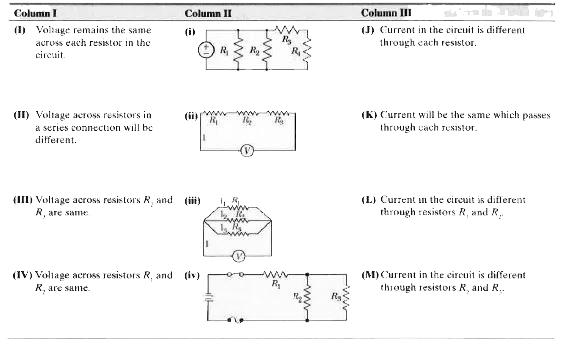 A(IV) (iv) (K)B(III) (iv) (M)C(II) (iii) (L)D(I) (i) (M)
A(IV) (iv) (K)B(III) (iv) (M)C(II) (iii) (L)D(I) (i) (M)There are mainly two types of combinations of resistors in a circuit, series and parallel. In the given table, Column I shows voltages of different arrangements of resistors, Column II shows different arrangement of resistors and Column III shows currents of different arrangements of resistors.
What are the conditions when resistors are in mixed combination, that is series and parallel combination respectively?
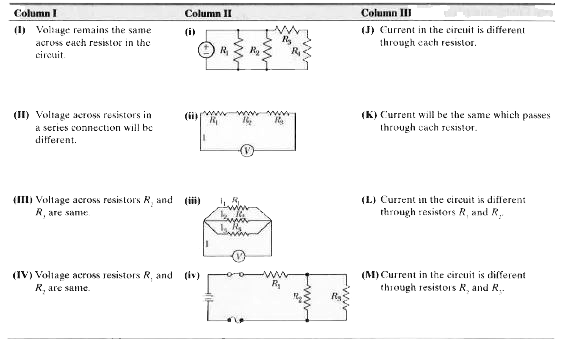 A(III) (i) (L)B(I) (i) (J)C(IV) (i) (L)D(II) (iii) (M)
A(III) (i) (L)B(I) (i) (J)C(IV) (i) (L)D(II) (iii) (M)Electrical current is the flow of charged particles. The electric current flows through a wire the same way as how water moves in a river. The electricity is nothing but the flow of electrons. There are two main combinations of resistors in circuit, that is series and parallel. In the given table, Column I shows different combinations of resistors, Column II shows voltages of different arrangements of resistors and Column III shows currents and voltage division needed or not in different arrangements of resistors.
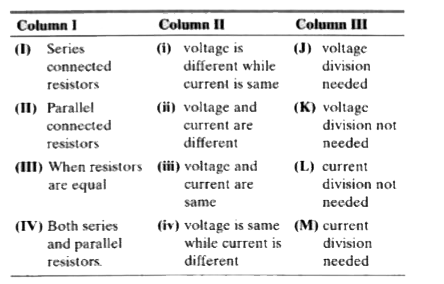
When there is no voltage division problem arise?A(II) (iv) (K)B(IV) (i) (M)C(III) (ii) (L)D(III) (iv) (K)
Out of the combinations of resistors mentioned above in the previous part, for a given voltage which combination will consume more power and why ?
View Solution(a) Two identical resistors each of resistance 10 ohm are connected :
(i) in series.
(ii) in parallel , in terun to a battery of 6V. Calculate the ratio of power consumed in the combination of resistors in the two cases.
(b) Establish the relationship between 1 kWh and SI unit of energy .
View SolutionElectrical current is the flow of charged particles. The electric current flows through a wire the same way as how water moves in a river. The electricity is nothing but the flow of electrons. There are two main combinations of resistors in circuit, that is series and parallel. In the given table, Column I shows different combinations of resistors, Column II shows voltages of different arrangements of resistors and Column III shows currents and voltage division needed or not in different arrangements of resistors.
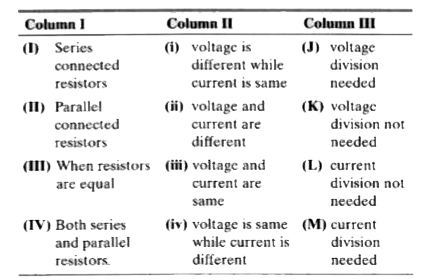
When does the current division problem arise?
View SolutionElectrical current is the flow of charged particles. The electric current flows through a wire the same way as how water moves in a river. The electricity is nothing but the flow of electrons. There are two main combinations of resistors in circuit, that is series and parallel. In the given table, Column I shows different combinations of resistors, Column II shows voltages of different arrangements of resistors and Column III shows currents and voltage division needed or not in different arrangements of resistors.
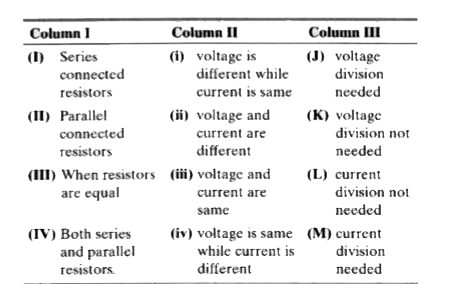
When does the voltage division problem arise?
View SolutionThere are mainly two types of combinations of resistors in a circuit, series and parallel. In the given table, Column I shows voltages of different arrangements of resistors, Column II shows different arrangement of resistors and Column III shows currents of different arrangements of resistors.
What are the conditions when resistor is in the parallel network?
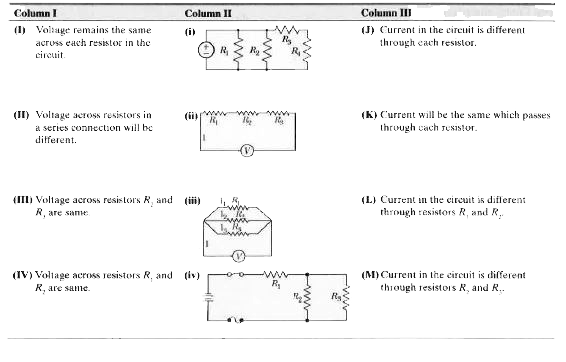
View Solution
